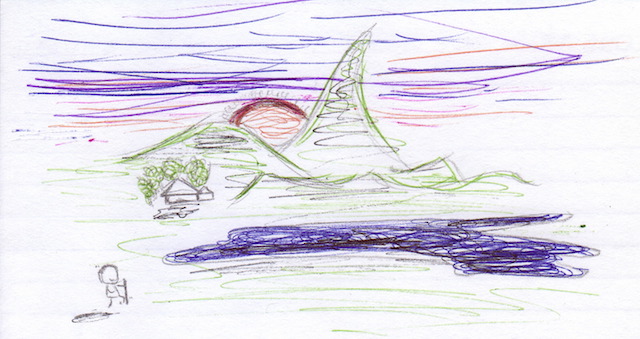During the previous school year, at the much beloved Maywood Community School, our Aboriginal Resource Teacher, Mary Hotomanie, led the staff for a professional development day, providing resources and first-hand wisdom in aid of an increased and nuanced understanding of how to approach the new provincial mandate for incorporation of First Nations traditional knowledge and ways of being across the curriculum, and an appreciation of why this was important and of value.
After a very emotional morning spent under the tutelage of Elder Gerry Oleman, of the St’at’imc Nation of Shalalth, BC, Mary led us through what is known as the Blanket Exercise. Developed by the social justice organization Kairos Canada, the Blanket Exercise is described as “a teaching tool to share the historic and contemporary relationship between Indigenous and non-Indigenous peoples in Canada.” During the Exercise, blankets are used to represent the traditional lands of the First Nations of Canada. Participants, taking the roles of the First Peoples, stand on these blankets as facilitators narrate the events of pre- and post-Contact and the impact these events had on the descendants of Canada’s original human occupants. As events affect the nations and territories of the First Peoples, the blankets are folded and refolded, becoming smaller and smaller, and are sometimes removed entirely, to represent the effect treaties (written in English), lack of treaties, forced removal, disease, and various colonialist government policy had on the land and, by association, the peoples of the First Nations.
For our staff, it was a very moving and unsettling experience, and I knew that it was something that I wanted to bring into my class the next year. As a sufferer of the curse of the ever-lifting bar of high standards, though, I wondered what could be done to increase the visceral impact the Exercise on students, so that it would live in their memories. I wondered what would happen if, instead of blankets, students spent a term creating visual representations of the first nations, if they really developed an understanding of the land and its uses and its special places, so that when the “blankets” were folded, they would understand exactly what was being lost, changed, or impacted?
Luckily, Ms. Hotomanie also works at Suncrest, so when this school year began, we were able to keep talking about this possibility.
The last piece fell into place when Ms. Papapanagiotou, who runs our sister 6/7 MACC class at Capitol Hill, and I were working through our planning for the year together and the idea of the Blanket Exercise was raised. What if our two classes did the Exercise together? What if we created groups with two partners from each class, and the two groups had to communicate electronically in order to create their nation maps, with each pair being responsible for one half of the map? Not only would we be able to cover a lot of the Social Studies curriculum, but we would also be able to stress the importance of the Core Competency Communication: by having to do the bulk of their planning and creation at a distance, students would have the opportunity to practice working in the “remote economy” – the idea being that if you had communicated well, when the two classes got together at the end of the term to join their nation maps the two pieces should fit seamlessly together, in terms of measurement and aesthetics.
This was followed by meetings and consultations with Ms. Hotomanie and Brandi Price, Mary’s counterpart at Capitol Hill, and then our two classes got to work during Term 3.
In previous terms, our classes had been penpals – one of the highlights of each month was when the mail arrived and letters were dispersed; there is still nothing like receiving a hand-written letter. In my class, the opening of mail was always followed, about five minutes later, by this request: “Can we write back right away?”
At the beginning of this term, Cap Hill paid us a half-day visit, and penpals got to meet each other face to face for the first time.
After introductions, we headed to the gym to blow off the steam of first impressions nerves with a few rounds of Squirrels vs. Mountain Lions and Staggered Relay Line Tag (there’s got to be a better name for that – MACC-sters: any suggestions?)…
…and then we got to work.
Two pairs of penpals were assigned to one of twelve nations representing four territories within B.C.: the Coast Salish, Kwakwaka’wakw, and Nisga’a Nations of the Coast; the Inland Tlingit, Tahltan, and Sekani Nations of the Northern Interior; the Okanagan, Secwepemc, and Tsilhqot’in Nations of the Southern Interior; and the Kaska Dena, Dane-Zaa, and Dene-Tha’ Nations of the Northeast.
Each group would be required to create a nation map, focusing on the pre-Contact period, with exact geography and symbolic or written representations of five aspects: resources and resource usage, governance, spiritual practices and beliefs, traditions and culture, and language. Each nation map would then be bordered with information regarding contemporary issues for that nation. An emphasis was placed on clear communication, so that even symbolic representation could be understood without an interpreter. Groups would also need to assign a generational role to each member – Elder, Chief, Adult, and Child – with each member being responsible for researching the responsibilities of that role and then writing a “Day in the Life” first- or third-person account based on that research. The project outlines for the two parts of the assignment, as well as the checklist we used for the first meeting, can be found below:
First Nations Studies project outline
First Nations Studies Generational Roles Writing
First Nations Studies First Day Group Checklist
This half-day would be their only in-person planning time for the project: about 45 minutes to divide the physical territory of their land into two, brainstorm a vision for the aesthetics of the project, and decide who would be responsible for each aspect of research and who would take on each generational role.
We then headed into two months of knowledge-building, on-line communication, and project creation.
We were lucky enough to have Ms. Hotomanie with us for an extended block every week for two months, in spite of a busy schedule that stretches her across many schools and a host of commitments. For the first part of each block, we focused on developing vocabulary and an appreciation for cultural protocols and traditional ways of being.
In one example of this work, we began with a deconstruction of the Acknowledgement of Territory used at school assemblies.
Each morning in Division Two, we do a timed index card drawing, an exercise stolen from cartoonist, author, and teacher extraordinaire Lynda Barry. From the beginning of the morning announcements to the end of Mrs. Hetrick’s Listening Program, students draw in response to a written prompt on the board. Here are the responses, at the beginning of our First Nations unit, to the prompt, “What does the Acknowledgement of Territory mean to you?” This gave us an idea of the knowledge and attitude the students were bringing with them into our discussions.
Stealing from the work of the intrepid and creative Mrs. Osiris of Chaffey-Burke, we worked through a word by word understanding of the text of the Acknowledgement, building to the search of an understanding of the verb “to acknowledge,” Mary and I turned our backs to the students and told them to get us to acknowledge them, while we refused to do so. Within two minutes, being unacknowledged turned polite “Excuse me”s to poking and then to shouts and people running out of the room and threats of theft and violence. (I may be willfully reading into this, but I have noticed an increased sense of focus now when these words are spoken in the school gym…)
Using the First Peoples’ Principles of Learning as a spine, Mary and I read various stories and shared various learnings with the class, asking the students to tie what they were reading and hearing back to the Principles, and to tie the Principles back to the own lives, in discussions and in written reflections.
One example of this work was in Mary’s reading of Nicola Campbell’s storybook Shi-Shi-Etko…
…balanced by a Socratic Circle after a reading and re-reading of the introduction of Richard Wagamese‘s collection of short essays, One Story, One Song (MACC-sters, take a look at the Wagamese link for a hint to one answer to the question that was raised during our reading of A Wrinkle in Time: can boys and girls be friends? 5 points in the Interconnectivity Contest for the first person to me with the connection…). The introduction can be read here: wagamese_intro
Here are some timed index card drawings from the prompt, “Draw an image that has stayed with you from ‘One Story, One Song'”:
And here are some index card drawings in response to the prompt, “Choose one of the Principles of Learning and show how it connects to your own life”:
We also explored Wagamese’s version of the points of the Medicine Wheel, emphasizing the definition and benefits of Humility…
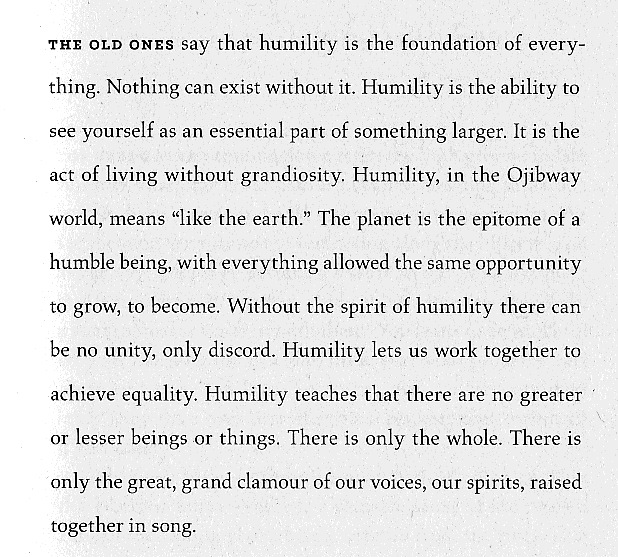
…and Introspection.
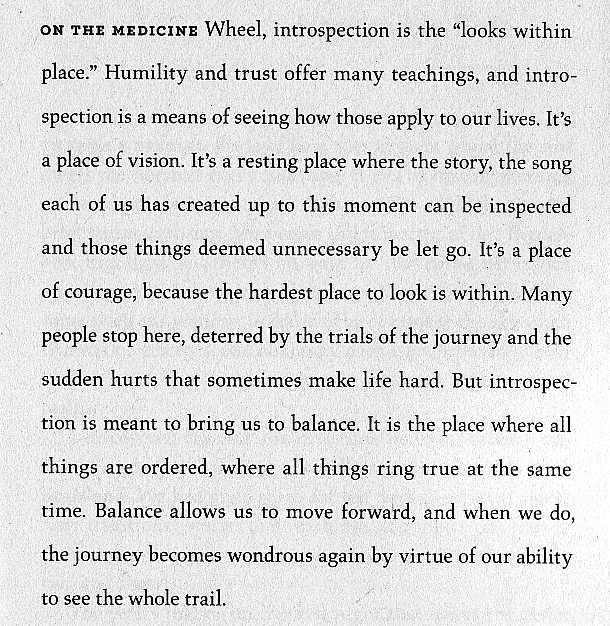
Tying in to our work in Art on the Core Competencies, attention was also paid to the First Nations, Metis, and Inuit Holistic Models of Learning (students need to create their own model, based on these, for their “Book of Me” Core Competencies self-assessment).
First Nations Holistic Lifelong Learning Model
Metis Holistic Lifelong Learning Model
Inuit Holistic Lifelong Learning Model
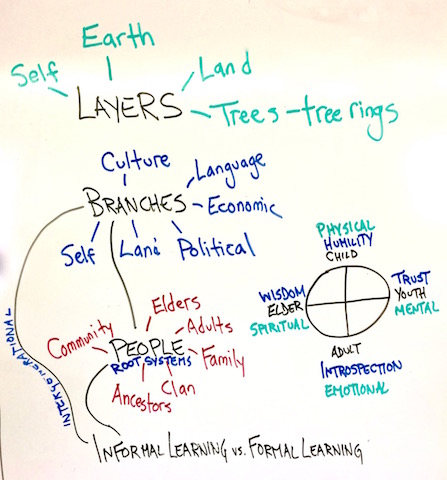
Attention was also paid to language – particularly the creation and use of the terms First Nations, Aboriginal, Indigenous, Native, and Indian; many students made the connection to a similar type of constructed language used to name, dismiss, segregate, or target African-Americans, as explored in Term 2. Ms. Hotomanie very clearly illuminated the benefits of knowing where, exactly, a person is from, and further connections were made back to Shi-Shi-Etko and Wagamese.
But the bulk of each session was spent in the creation of the nation maps. Communicating via google chat, email, and video chat, the two sets of pairs got down to work, researching and creating their half of each nation’s map.
Along the way, they also researched and wrote about the generational role they had chosen at their first planning session, writing from either a pre- or post-colonization perspective. Here’s a few examples:
As with so many things, Ms. Hotomanie was our best resource here. Over the course of a few weeks, she met with each generational group and orally shared her knowledge, in helpful and meaningful detail.
Here are some index card drawings from a few weeks into the process, in response to the prompt, “Draw an image or images of things that surprised you or that you have found interesting in your research”:
In the middle of this process, we took a field trip to Lynn Canyon. The Canyon is one of my special places – I grew up at the foot of one of the lower access trails and it was our backyard while growing up. As an adult, I go there at least once a week, all year round, for a “green bath” – and as we were exploring the importance of connection to place, it felt right to take the class there and share this special place with them.
After a few exercises to wake up our senses, we headed in, guided by the question, “In the Squamish language, the word used to identify this place [my notes say kw’ayatsut, but I cannot find the photo I had confirming this…] translates as ‘purify’ – why do you think they used that word?”
Along the way we visited the Pet Cemetery…
…made some Andy Goldsworthy-inspired ephemeral art…
…and took some time apart to sit and be and make notes on what we observed.
Here’s a Wordle made from the students’ observations (the bigger the word, the more times it was used in their collective observations):
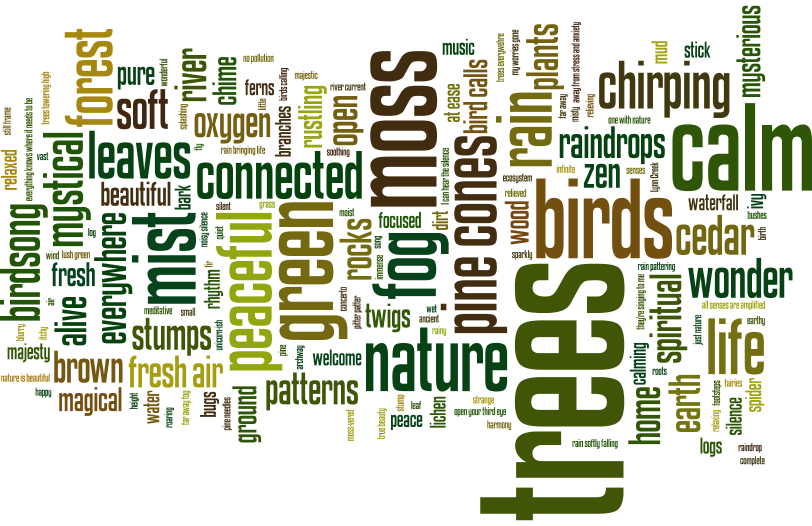
(Some of my favorites were just used once and are therefore too small to read here, like “Everything knows where it needs to be” and “rain bringing life” and “I can hear the silence” and “My worries are gone” and, of course, “unicorn-ish.”)
Every so often, we would stop to take an extended silent moment in observation of a place or thing, and then students wrote, on a small piece of paper, the word or words they felt best conveyed the essence of their experience. When we returned to class, groups each chose one of the places and turned these collections of words into Place Poems. Every word in the collection – even repeats – had to be used in the creation of the poem; groups could add words to help create sense, but they could not remove any words.
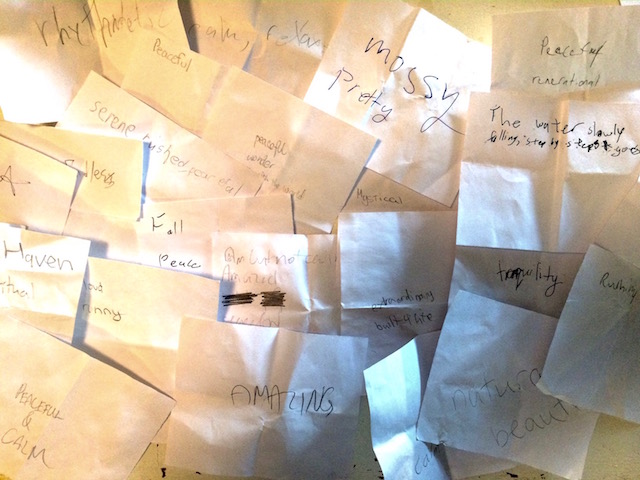

Here are the results:
Pet Cemetery
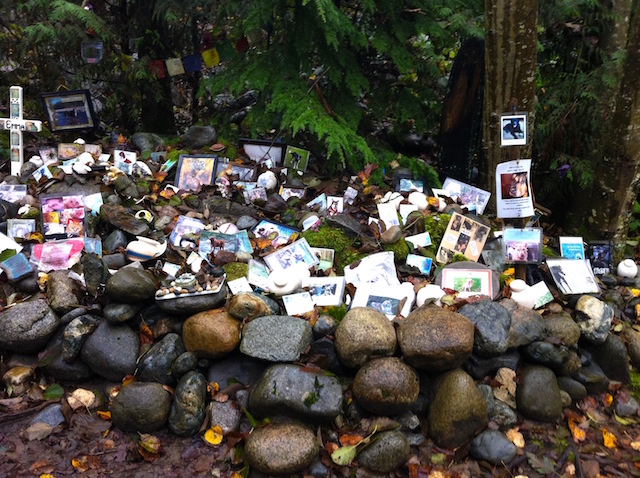
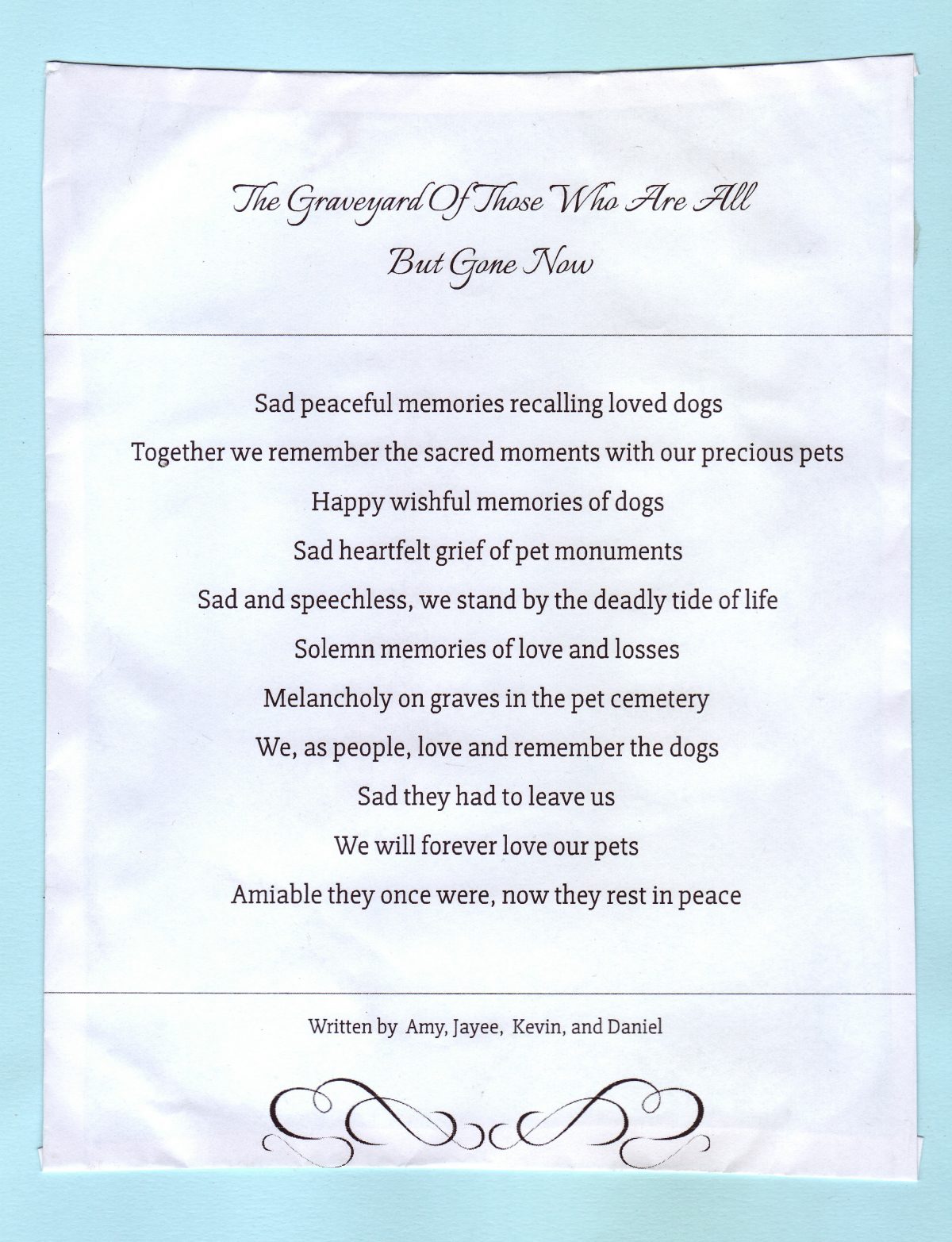
Small Waterfall
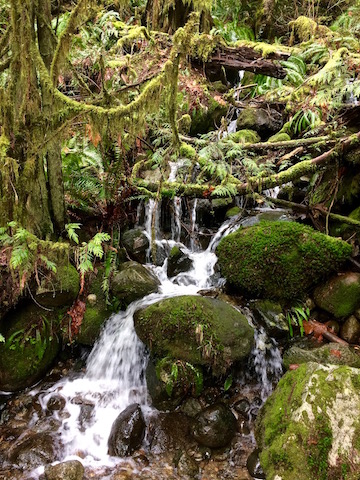
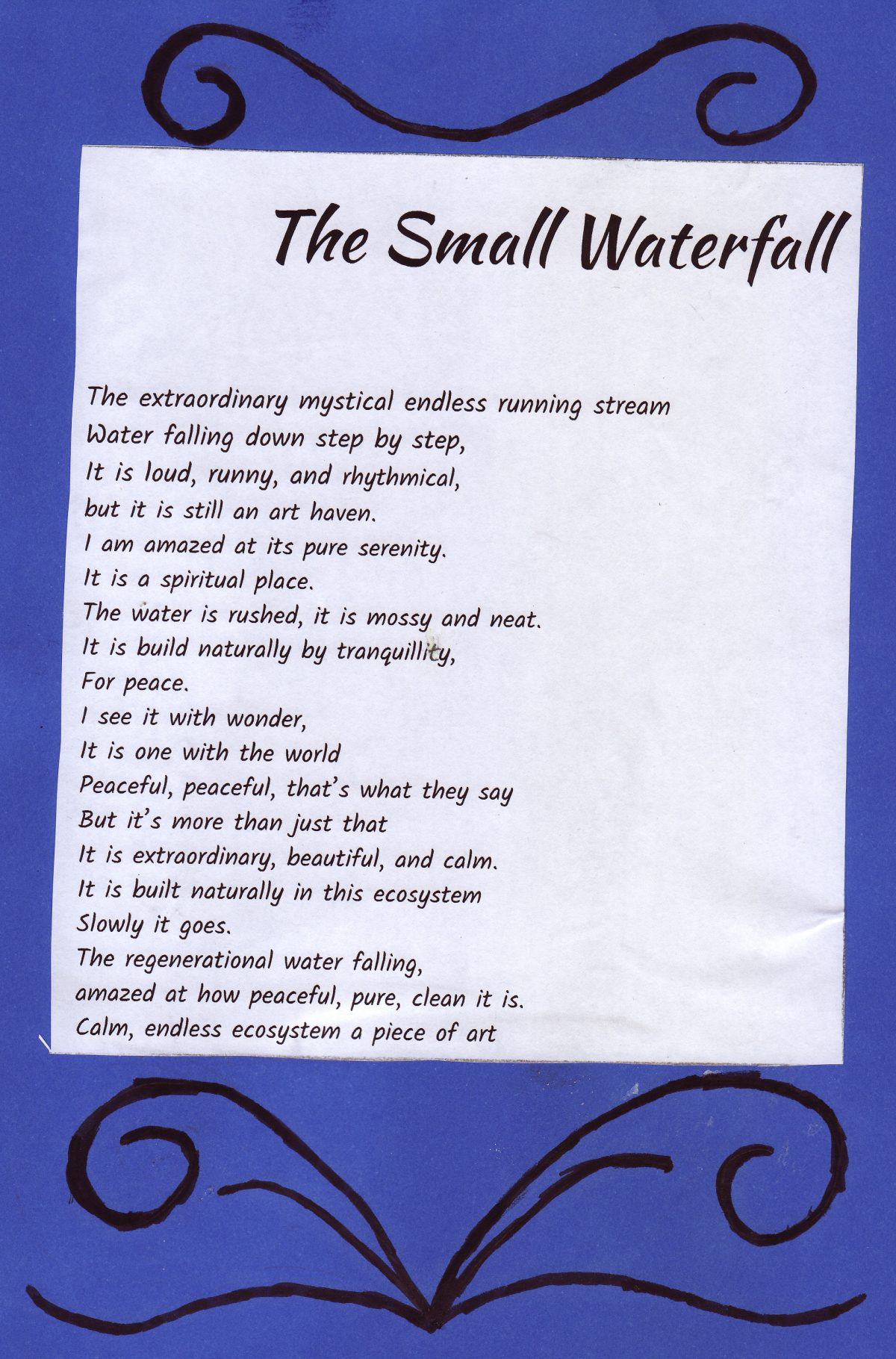
Hidden Forest Troll
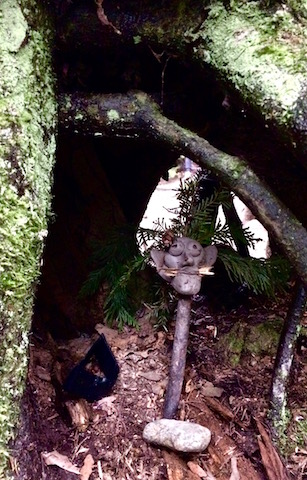
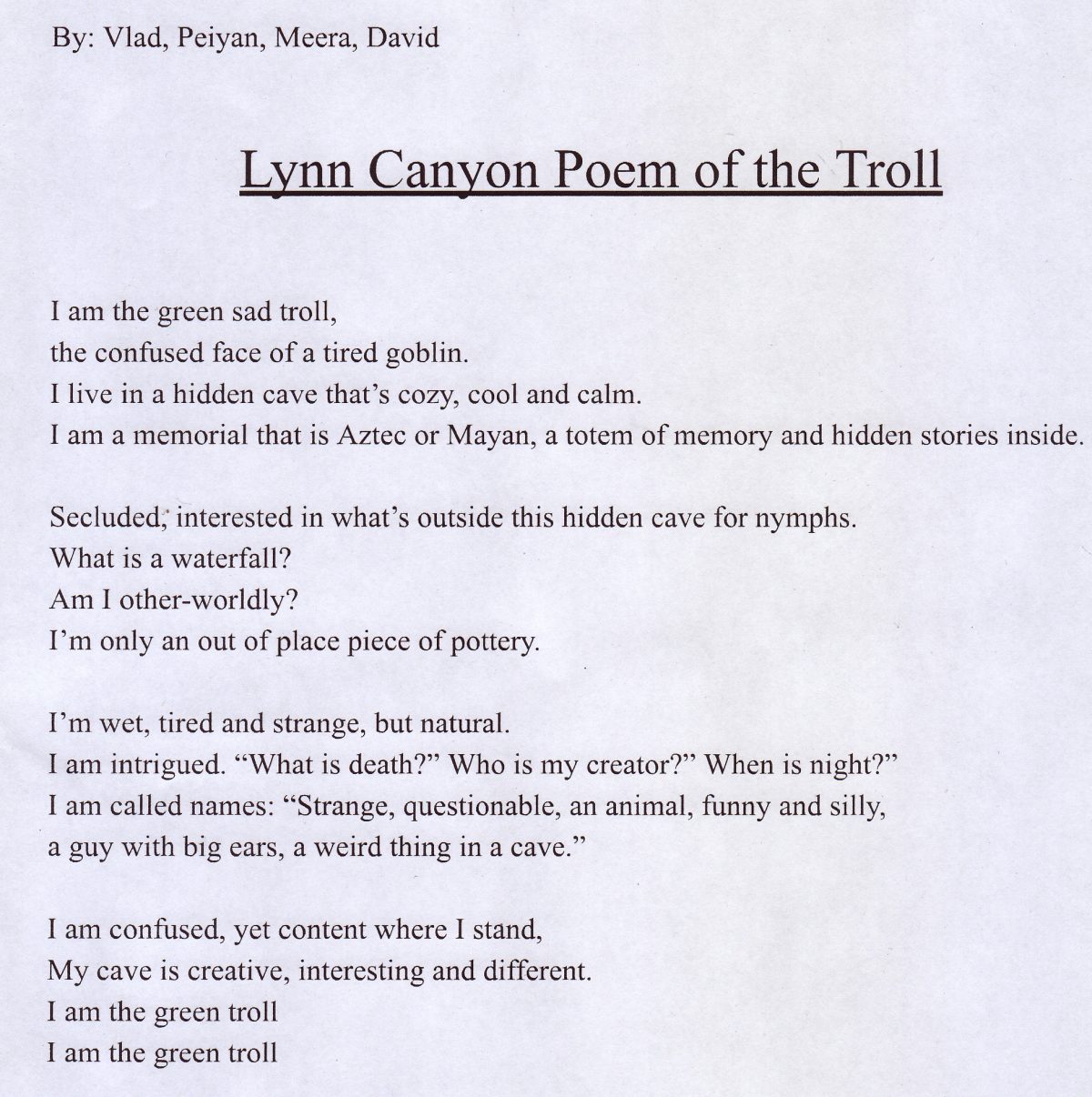
Before the Suspension Bridge
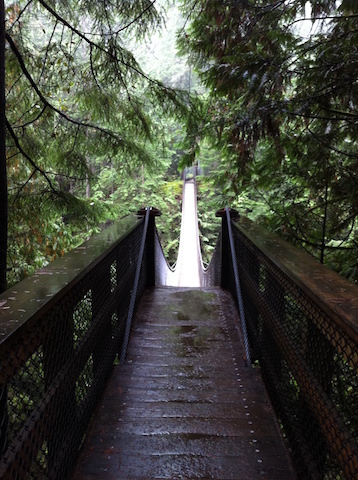
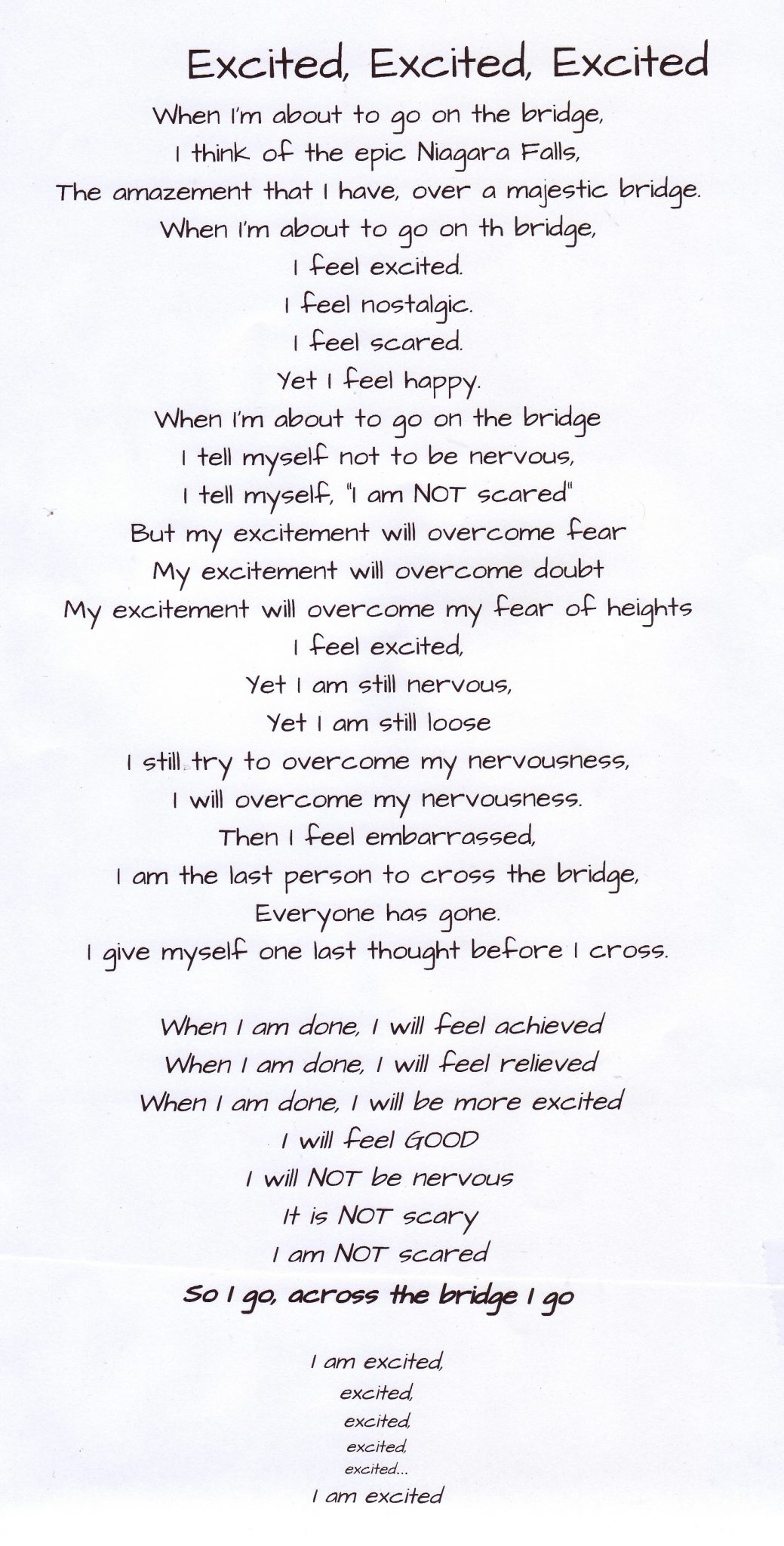
After the Suspension Bridge
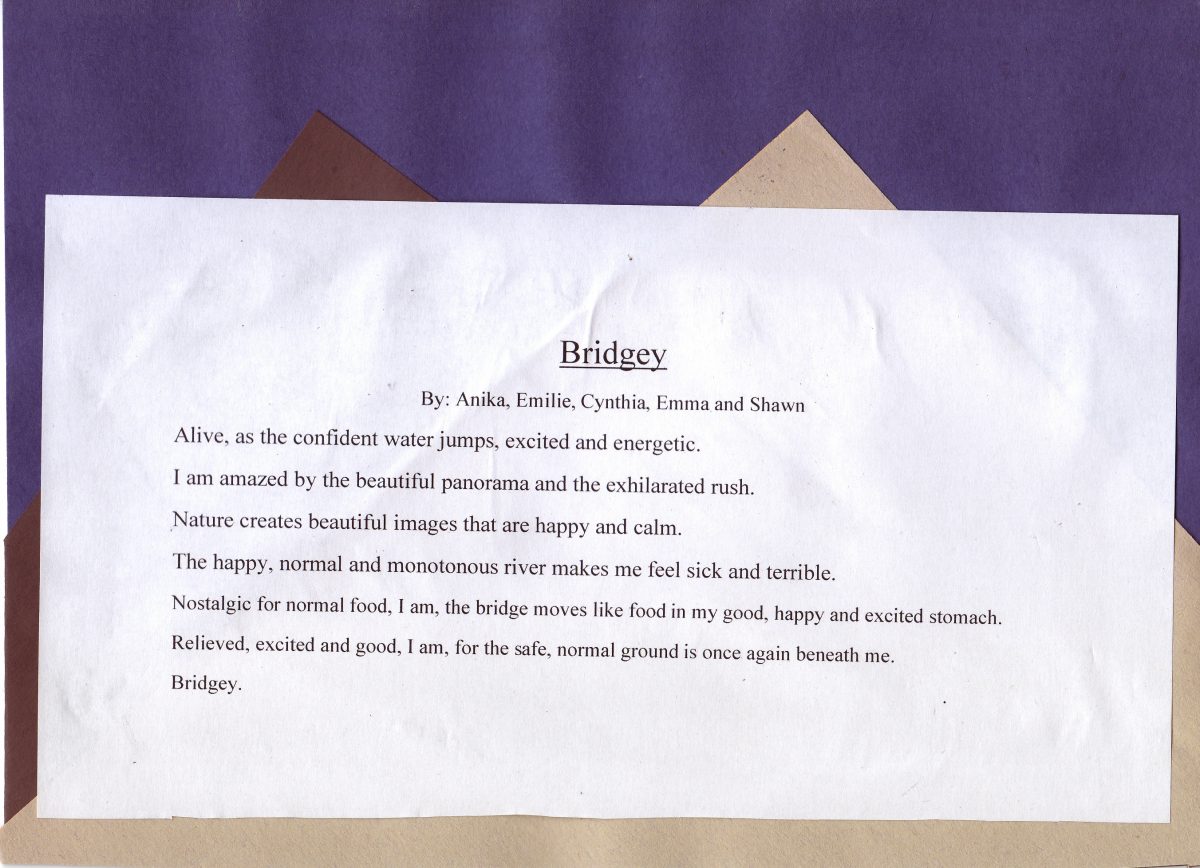
After playing about 5000 rounds of Camouflage, we stopped in to the Ecology Center for a scavenger hunt, in which students explored the Center’s interactives to receive eco-system themed clues to a word puzzle.
The next day, here were the drawn responses to our guiding question about the Squamish naming of Lynn Canyon:
Back in class, our nation maps were reaching their due date, and finishing touches were being made:
And then we travelled to Capitol Hill, for a full day with our sister class.
Maps were joined…
…and we headed to the gym to set up for the Blanket Exercise. I have to say, it was uncanny how alike so many of the two halves of the maps were – a testament to clear communication.
As but one example, take a look at how exactly these border and river lines match up, and remember that this work was all done via on-line communication, sight unseen:
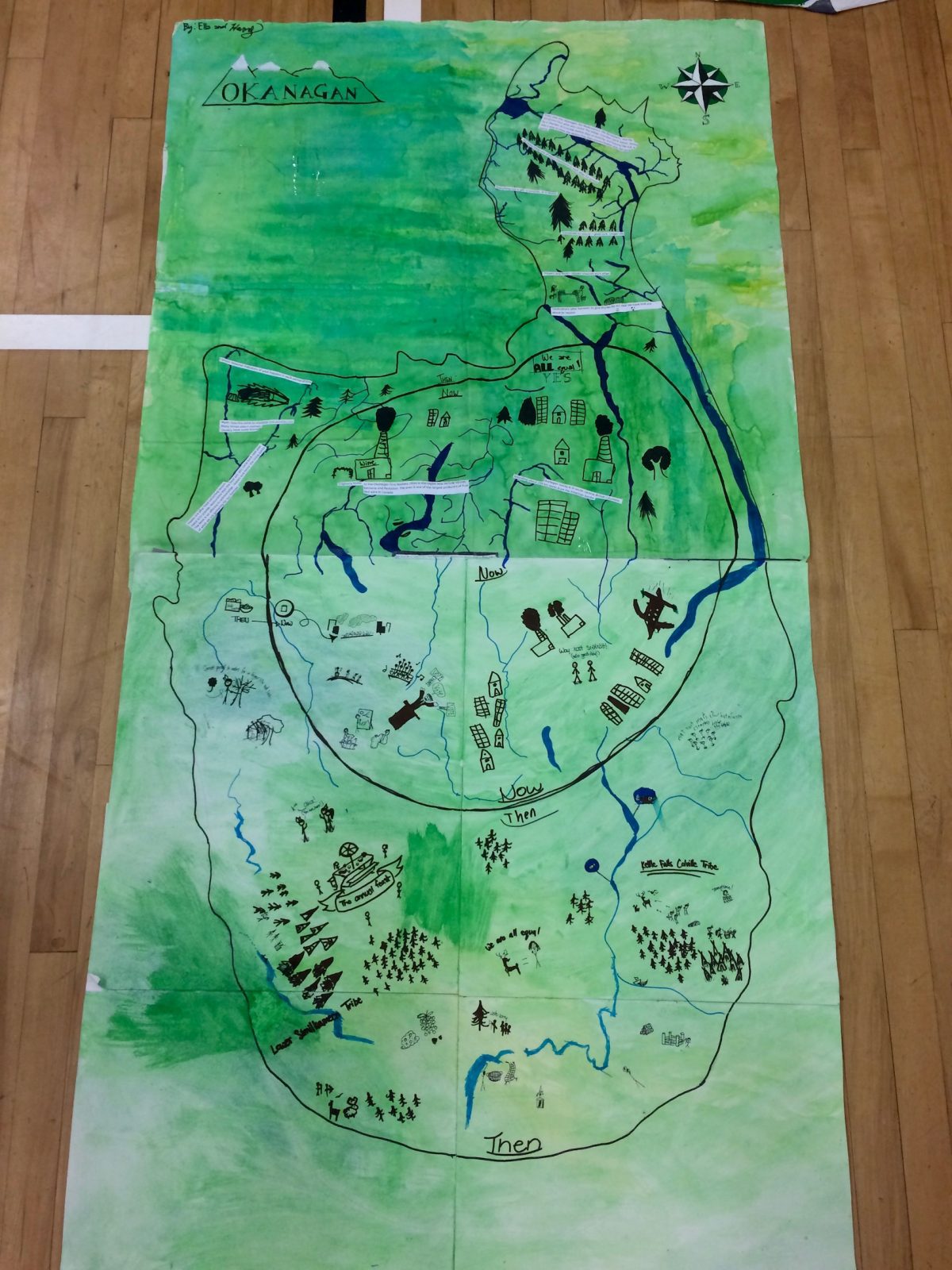

Some groups opted for symbolic representation, like this representation of the loss of fluent speakers of a nation’s language:
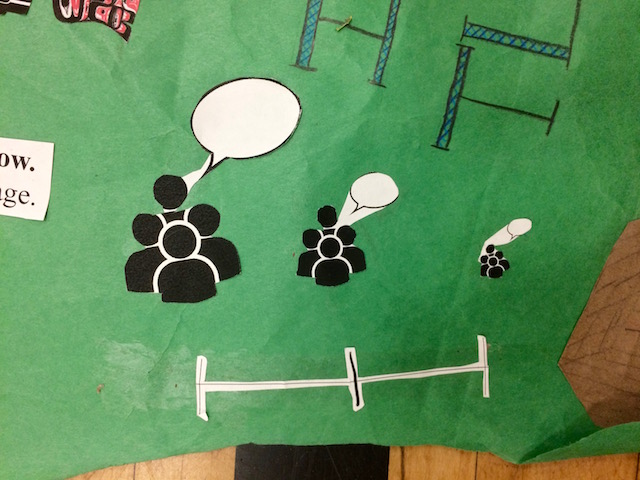
While others favored sharing their ideas through text:
So many amazing details:
Ms. Hotomanie and Ms. Price explained how the Exercise was going to work:
And then we began:
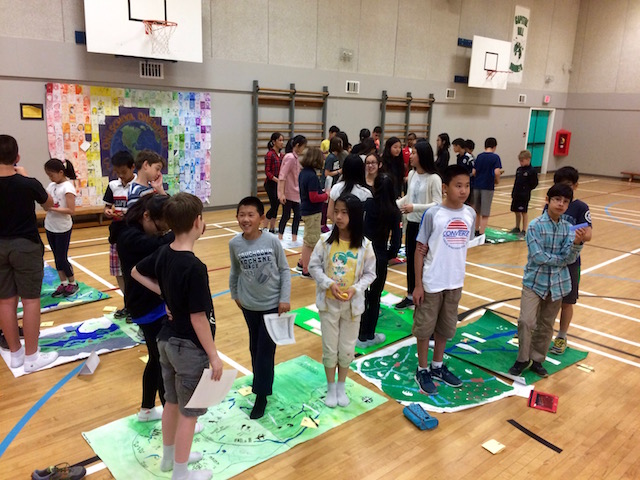
Within about 15 minutes, we had lost the majority of the participants to small pox and other diseases brought to Canada by the Europeans:
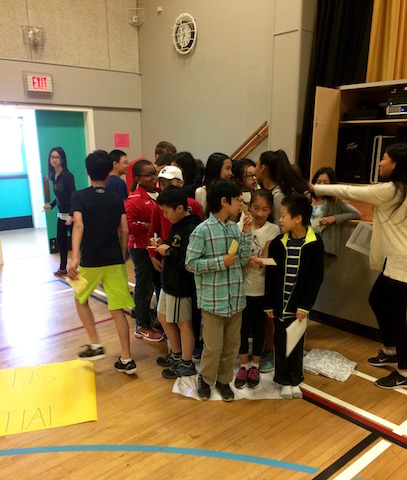
And then land was taken away.
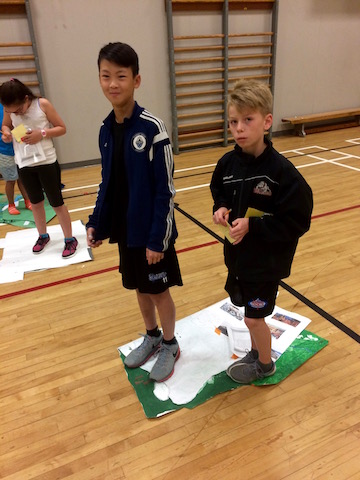
And taken away.
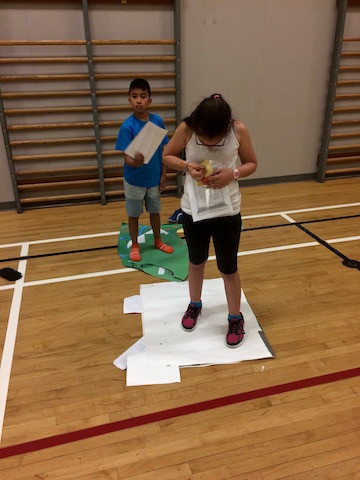
And taken away.
When the first map was folded and creased, there were a lot of gasps in the gym, in empathy for the group whose hard work had just been marred.
“We worked on that for ages!”
“Two months!”
And then a realization of perspective, remembering the opening words of the Exercise:
Narrator: These blankets represent the northern part of Turtle Island, or what we now know as Canada, before the arrival of Europeans. You represent the Indigenous peoples, the people who have been here for at least 10,000 years. Long before the arrival of Europeans, Turtle Island was your home, and home to millions of people like you. You lived in hundreds of nations. You fished and hunted and farmed. Each community had its own language, culture, traditions, laws and governments. As communities you often worked together and cooperated with one another. Like with all people, sometimes there was conflict. Before the newcomers arrived, one of the ways in which you, the original peoples, ended disputes was by making treaties.
Narrator: The land is very important to you. All of your needs – food, clothing, shelter, culture, your spirituality – are taken care of by the land, which is represented here by the blankets. In return, you take very seriously your responsibility to take care of the land.
The Exercise does a wonderful job of not focusing exclusively on the dire: in the last years of the time-line, focus is given to the impact of elders and young leaders in First Nations communities, who have and are fighting to reclaim land, language, and culture, and pieces of the “blankets” were unfolded to reflect this; but there were also many moments of intense silence, as when the children of the nations were taken away to attend residential schools – in the Exercise, these people return to the blankets, but are asked to sit, with their backs to the surviving members, to symbolize their disconnect from their communities.
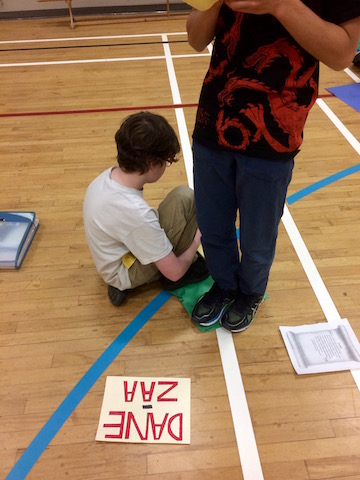
This is where we started:
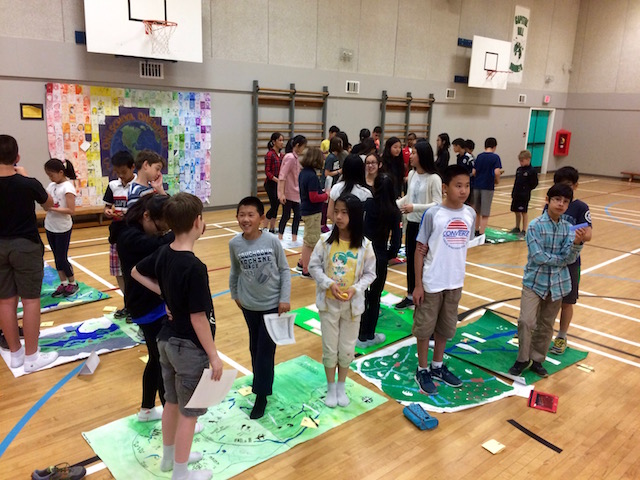
And this is where we finished:
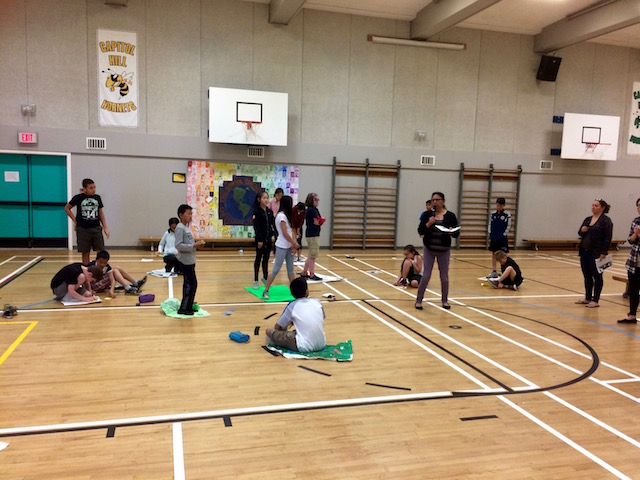
After lunch, we returned for a Circle, to debrief the Exercise:
And then Ms. Price shared a video with an up-lifting “What now?” message:
This experiment was not without its struggles: it ended up being much bigger in scope that any of us realized, I think; and it was a challenge to consistently find times when both classes could be on-line together; and there was a decided lack of resources, especially those covering the pre-Contact period – but in the end, the impact was (I think!) as profound as we had hoped.
In the days following the final get-together, students wrote reflections about their experience.
Here are a few quotes:
“I never really felt how they (First People’s) did until the Europeans folded up our land, crushed our mountains, and killed us by smallpox. It scared me in some ways, leaving a mark that I would remember. It was personal, because I had spent many hours working to build that. There is an old saying my mother always told me, ‘Put yourself in someone else’s shoes’. To answer ‘What Now?’ I say that we must do something about this. In the end, what we learn much benefits the community. So with this knowledge in our head, we should take action.”
“I feel like that simulation brought light to my thinking.”
“We lost Gerry and Deryk.”
“Our socials project this term involved looking deeper into the lives of First Nations people, particularly that of our assigned tribes. We did this in a way that since we were each looking into a singular role of a singular tribe, we could go immensely deeper than just the learning process that we would use if we were just looking at First Nations from an ‘overall’ perspective.”
“I think from this unit, I walk away with more awareness. We need to watch the way we talk. The First Nations are people just like us. They deserve the equality we have.”
“It makes me sick that the “winners” get to write history.”
“What now? Now that we have this knowledge, we can take it and use it to help others understand and show support. You can pay attention to the news and if you see an event you could go to it. It shows that you want to be part of reconciliation.”
“I learned the history of the Kwakwaka’wakw tribe, by Ms. Price’s stories that she spoke from experience. When I was talking to her, she explained it so vividly, I nearly felt as if I was there. All her knowledge was being shared the same way it was thousands of years ago!”
And here are a couple of full-length examples:
A huge thank you to Mary and Brandi for sharing their time, wisdom, and knowledge with us – students and teachers alike. They were our most valued and valuable resource. And thank you MACC-sters, north and south, for being so game and investing so much of your time and energy into this project. We were so impressed with your work and the depth of your learning. Remember: your commitment to these nations that you spent so much effort getting to know and appreciate does not end here; in fact, this is just the beginning…






